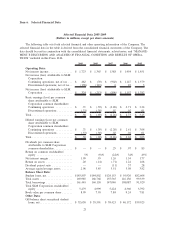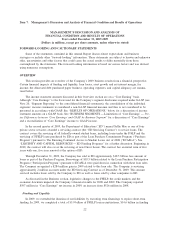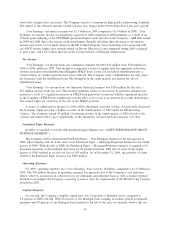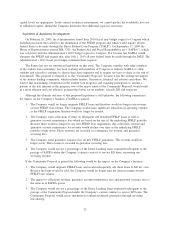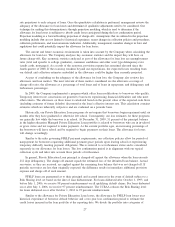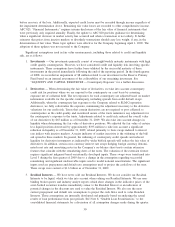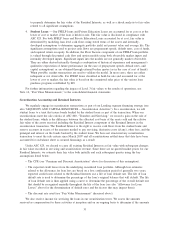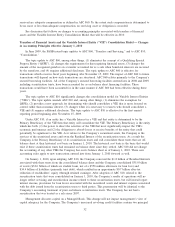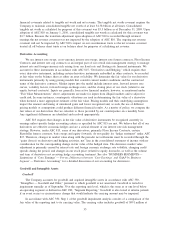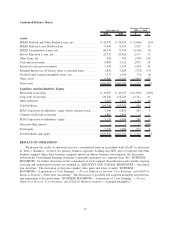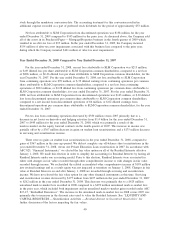Sallie Mae 2009 Annual Report Download - page 31
Download and view the complete annual report
Please find page 31 of the 2009 Sallie Mae annual report below. You can navigate through the pages in the report by either clicking on the pages listed below, or by using the keyword search tool below to find specific information within the annual report.before recovery of the loss. Additionally, expected credit losses must be recorded through income regardless of
the impairment determination above. Remaining fair value losses are recorded to other comprehensive income.
ASC 825, “Financial Instruments,” requires interim disclosures of the fair value of financial instruments that
were previously only required annually. Finally, the update to ASC 820 provides guidance for determining
when a significant decrease in market activity has occurred and when a transaction is not orderly. It further
reiterates that prices from inactive markets or disorderly transactions should carry less weight, if any, in the
determination of fair value. These topic updates were effective for the Company beginning April 1, 2009. The
adoption of these updates was not material to the Company.
Significant assumptions used in fair value measurements, including those related to credit and liquidity
risk, are as follows:
1. Investments — Our investments primarily consist of overnight/weekly maturity instruments with high
credit quality counterparties. However, we have considered credit and liquidity risk involving specific
instruments. These assumptions have further been validated by the successful maturity of these
investments in the period immediately following the end of the reporting period. In the fourth quarter
of 2008, we recorded an impairment of $8 million related to our investment in the Reserve Primary
Fund based on an internal assessment of the collectability of our remaining investment. See
“LIQUIDITY AND CAPITAL RESOURCES — Counterparty Exposure” for a further discussion.
2. Derivatives — When determining the fair value of derivatives, we take into account counterparty
credit risk for positions where we are exposed to the counterparty on a net basis by assessing
exposure net of collateral held. The net exposures for each counterparty are adjusted based on market
information available for the specific counterparty, including spreads from credit default swaps.
Additionally, when the counterparty has exposure to the Company related to SLM Corporation
derivatives, we fully collateralize the exposure, minimizing the adjustment necessary to the derivative
valuations for our credit risk. Trusts that contain derivatives are not required to post collateral to
counterparties as the credit quality and securitized nature of the trusts minimizes any adjustments for
the counterparty’s exposure to the trusts. Adjustments related to credit risk reduced the overall value
of our derivatives by $65 million as of December 31, 2009. We also take into account changes in
liquidity when determining the fair value of derivative positions. We adjusted the fair value of certain
less liquid positions downward by approximately $195 million to take into account a significant
reduction in liquidity as of December 31, 2009, related primarily to basis swaps indexed to interest
rate indices with inactive markets. A major indicator of market inactivity is the widening of the bid/
ask spread in these markets. In general, the widening of counterparty credit spreads and reduced
liquidity for derivative instruments as indicated by wider bid/ask spreads will reduce the fair value of
derivatives. In addition, certain cross-currency interest rate swaps hedging foreign currency denomi-
nated reset rate and amortizing notes in the Company’s on-balance sheet trusts contain extension
features that coincide with the remarketing dates of the notes. The valuation of the extension feature
requires significant judgment based on internally developed inputs. These swaps were transferred into
Level 3 during the first quarter of 2009 due to a change in the assumption regarding successful
remarketing and significant unobservable inputs used to model notional amortizations. The significant
inputs used are prepayment and default rate assumptions used to project the cash flows of the trust.
These swaps were carried at $1.6 billion as of December 31, 2009.
3. Residual Interests — We have never sold our Residual Interests. We do not consider our Residual
Interests to be liquid, which we take into account when valuing our Residual Interests. We use non-
binding broker quotes and industry analyst reports which show changes in the indicative prices of the
asset-backed securities tranches immediately senior to the Residual Interest as an indication of
potential changes in the discount rate used to value the Residual Interest. We also use the most
current prepayment and default rate assumptions to project the cash flows used to value Residual
Interests. These assumptions are internally developed and primarily based on analyzing the actual
results of loan performance from past periods. See Note 8, “Student Loan Securitization,” to the
consolidated financial statements for a discussion of all assumption changes made during the quarter
30



